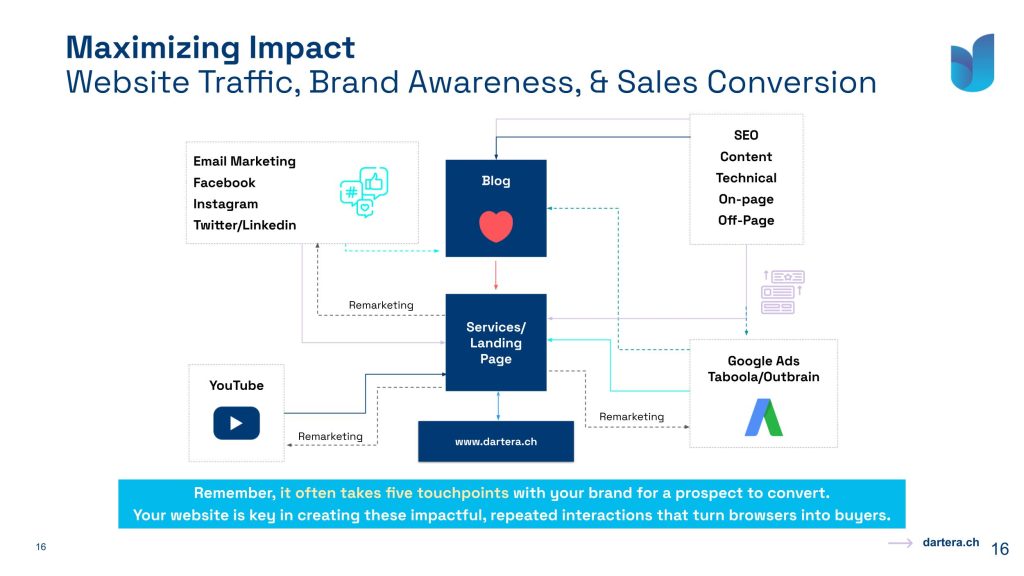More sales with lead generation

In the digital age, acquiring qualified leads is not only a challenge, but also an essential prerequisite for business success. Companies of all sizes are increasingly relying on advanced lead generation strategies to not only increase their visibility, but also to significantly increase their sales. The ability to generate leads effectively determines growth and competitiveness in an increasingly networked world.
Get More Revenue
The importance of lead generation
Lead generation is the process of systematically identifying and cultivating potential customer interests until they ultimately become real business opportunities. This process is fundamental to sales management and is directly linked to increasing sales. Effective lead generation strategies enable companies to act in a more targeted manner, use marketing resources more efficiently and ultimately improve conversion rates.
Through targeted measures in lead generation, companies can:
- Increase reach: By addressing new and relevant target groups, companies expand their market presence.
- Gain customer insights: Valuable data about potential customers can be collected through interactions and engagement, helping to optimize marketing and sales strategies.
- Strengthen customer relationships: Through regular communication and customized offers, companies can build lasting relationships and strengthen customer loyalty.
- Increase sales: Ultimately, qualified leads lead to increased sales opportunities, which directly increases sales.
Strategies for effective lead generation
Lead generation strategies have changed drastically over the years. While traditional methods such as cold calling or mass mailings are still justified, digital strategies are becoming increasingly important. The most effective lead generation methods use a combination of inbound and outbound approaches to address different customer needs and cover different stages of the customer journey:
- Inbound methods such as search engine optimization (SEO), content marketing and social media use the power of content to attract prospective customers in a natural way. They focus on providing value and building trust before seeking to sell directly. This approach not only promotes lead quality, but also improves the customer experience.
- Outbound methods, on the other hand, are more direct and proactive. They include tactics such as direct mail, cold mailing and event marketing, which aim to attract attention quickly and achieve fast results. These tactics are particularly effective when it comes to reaching specific target groups in a short space of time.
By integrating these diverse approaches, companies can develop a robust lead generation strategy that not only increases sales but also contributes to sustainable business growth. In the following sections, we will look at the individual components of lead generation in detail and provide specific tips and strategies to optimize your lead generation activities and ultimately generate more sales.
Inbound lead generation: strategies and applications
Inbound lead generation is a powerful way to attract prospects naturally and organically. Unlike outbound methods, which can often be perceived as intrusive, inbound is based on the creation of valuable content that attracts potential customers at the exact moment they are looking for solutions.
Definition of inbound lead generation
Inbound lead generation is the process by which companies create valuable content and experiences that are tailored to the specific needs and interests of their target audience. The aim is to encourage potential customers to contact the company on their own initiative. This method uses various digital platforms to distribute content and encourage interaction, generating leads in a way that increases their willingness to buy.
Use of SEO in inbound lead generation
Search engine optimization (SEO) plays a central role in any inbound marketing strategy. By optimizing your website and content for search engines, you ensure that your target customers find you when they are looking for relevant topics or solutions. Effective SEO not only helps to increase visibility, but also boosts your company's credibility and attracts high-quality leads. Learn more about our SEO services designed to maximize your online presence.
Content marketing for lead generation
Content marketing is at the heart of inbound lead generation. By providing high-quality, relevant content, you can not only generate interest, but also build trust and demonstrate your expertise. Whether through blog posts, whitepapers, infographics or videos - every content format has the potential to appeal to your target group and encourage interaction. Visit our content strategy page to find out more about how we can help you develop and implement your content strategy.
Use of SEA (search engine advertising) and social media PPC
Search engine advertising (SEA) and pay-per-click advertising on social media are other important components of inbound lead generation. Through targeted advertising campaigns in search engines and on platforms such as Facebook, Instagram and LinkedIn, you can ensure that your offers and content are presented precisely when potential customers are actively searching for similar solutions. These methods enable fast results and a precise focus on your target group, which makes lead generation efficient and effective. Find out about our SEA services designed to optimize your advertising spend and maximize ROI.
By combining these methods, companies can create a strong inbound lead generation campaign that not only increases visibility, but also attracts prospects who already show some interest and intent. This leads to higher conversion rates and ultimately to more sales.
Outbound lead generation: focus on cold mailing
While inbound lead generation aims to attract potential customers who are already actively looking for your products or services, outbound lead generation uses proactive methods to approach potential customers directly. Cold mailing is one of these methods and continues to play a decisive role in the sales strategies of many companies despite the flood of digital means of communication.
Cold mailing as the primary outbound method
Cold mailing refers to the process of sending unsolicited emails to potential customers who have not yet had any direct interaction with your company. Personalization is the key here: according to a study by Experian, personalized emails can increase transaction rates by up to six times. Targeted messages that address the specific needs and interests of the recipient not only attract attention, but also increase the likelihood of a response. (Source: Experian)
Integration of further outbound methods
Although cold mailing is effective, it is often complemented by other outbound methods such as cold calling and direct mail to maximize the reach and effectiveness of lead generation strategies:
- Cold calling: This method enables immediate feedback and personalized interactions. A study by Baylor University shows that a sales representative has to make an average of 209 calls to close a new deal. (Source: Baylor University)
- Direct advertising: Despite the digital age, direct advertising still has its strengths, especially in certain target groups. The Data & Marketing Association reports that direct mail has an average response rate of 4.4%, compared to 0.12% for email campaigns. (Source: Data & Marketing Association)
These methods enable companies to address different segments of the market and reach a broader range of potential customers. By combining cold mailing, cold calling and direct advertising, companies can not only increase the number of leads, but also improve their quality and ultimately convert them more successfully.
The role of web design in lead generation
An intuitive and appealing web design is crucial for successful lead generation. It influences the first impression and motivates potential customers to get in touch with your company.
A well-designed website not only optimizes the user experience, but also integrates strategically placed call-to-actions that encourage visitors to take specific actions. This effectively increases the conversion rate and thus the number of leads generated. In addition, mobile optimization is indispensable nowadays, as the majority of users access web content via mobile devices. A responsive design ensures that your website works smoothly on all devices and that search engines treat it preferentially.

At Dartera, we understand the importance of professional web design that goes beyond aesthetic requirements and actively contributes to lead generation. Our solutions are designed to optimize the user experience and support your digital marketing goals.
By implementing design principles specifically focused on lead generation, we transform your website into a powerful tool that not only attracts visitors, but also converts them into qualified leads.
Lead management, qualification and performance measurement
Effective lead management involves the systematic organization, qualification and nurturing of prospective customers with the aim of guiding them through the sales funnel until they close the deal. Here are some precise strategies and practical tips for implementing these processes:
Lead scoring: what it is and how to implement it
What it is:
Lead scoring is a process in which points are assigned to each lead based on their behavior or certain demographic characteristics that indicate their sales readiness. This helps companies prioritize the leads that are most likely to convert.
How to implement it:
- Define criteria: Identify behaviors and demographics that indicate high interest and purchase intent. Examples include website visits, downloaded content and completed contact forms.
- Allocate points: Develop a scoring system that assigns higher scores for activities that are more indicative of purchase intent.
- Use automation: Use CRM software that automatically handles and adjusts lead scoring based on leads' interactions with your marketing activities.
Lead nurturing: what it is and how to implement it effectively
What it is:
Lead nurturing is the process by which companies build and maintain relationships with potential customers by providing them with relevant information at the right moment. The aim is to accompany and support the leads through to the purchase decision.
How to implement it:
- Segmentation: Divide your leads into different groups based on their scoring and specific needs.
- Develop a content strategy: Create audience-specific content tailored to the needs and interests of each segment to drive engagement and build trust.
- Diversify communication channels: Use a combination of emails, social media, personal calls and other channels to spread your nurturing messages.
Use of CRM systems: Importance and optimization strategies
What it is:
CRM (Customer Relationship Management) systems are technological platforms that companies use to manage all aspects of customer interactions and relationships. They are essential for lead management as they provide a central data source and automate processes.
How to optimize them:
- Data integration: Make sure your CRM system captures all relevant data from each lead, including interaction history and any demographic information collected.
- Workflow automation: Set up automated workflows that automate common tasks such as sending follow-up emails and updating lead statuses.
- Performance monitoring: Use the analytical capabilities of CRM to regularly evaluate and improve the effectiveness of your lead-nurturing campaigns and scoring models.
By implementing these advanced techniques, companies can improve their lead qualification and ensure that their marketing and sales efforts are focused on the most promising prospects, ultimately leading to higher conversion rates and better ROI.
Future outlook and technological trends in lead generation
Digital transformation has dramatically changed the landscape of lead generation, especially in the B2B sector. Traditional methods such as direct mailing campaigns and cold calling are increasingly being supplemented or even replaced by digital strategies. Technologies such as artificial intelligence, machine learning and big data are playing an increasingly important role by improving efficiency and providing deeper insights into customer behavior and preferences. These tools allow companies to refine their lead generation strategies and develop more personalized, engaging campaigns that are better aligned with the needs of the modern shopper.
Conclusion and recommendations for action
To summarize, effective lead generation requires a mix of traditional and modern techniques that complement each other. Companies should focus on integrating advanced digital tools that help them to better understand and reach their target groups. The following steps can help companies optimize their lead generation and increase sales:
- Adopt new technologies: Leverage advanced analytics tools and automated marketing platforms to make better use of your data and personalize your marketing campaigns.
- Improve data quality: Ensure that you continuously collect and maintain high-quality data to improve the accuracy of your lead scoring models and the relevance of your marketing campaigns.
- Training your team: Invest in training your marketing and sales teams so they are familiar with the latest tools and techniques and can use them effectively.
- Evaluate and adjust: Regularly monitor the performance of your lead generation strategies and adjust them to respond to changes in the market and the behavior of your target group.
If you need support in developing or optimizing your lead generation strategies, Dartera is here to help. Contact us for a free consultation where we can jointly evaluate your current strategies and discuss ways to increase your sales through effective lead generation. 👉 Request a free strategy call now
By implementing these recommendations and utilizing our expertise, you can ensure that your lead generation strategies not only remain current, but are continuously improved to meet the changing demands of the market. This will ultimately help to increase your conversion rates and sustainably boost your sales.








